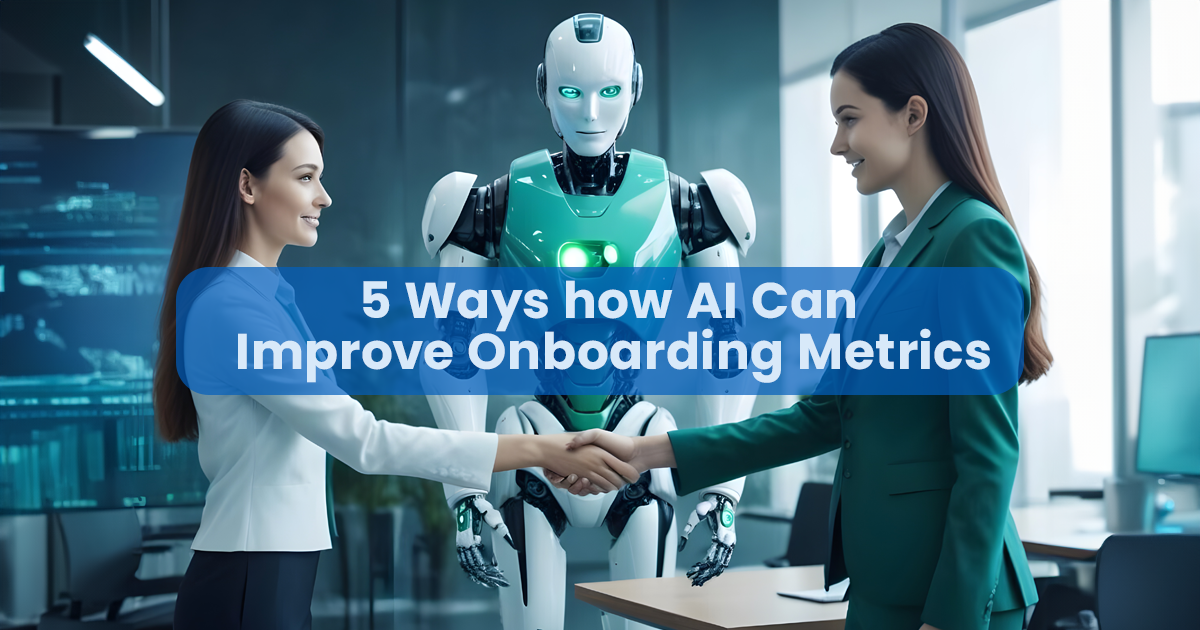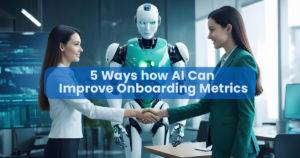5 Ways how AI Can Improve Onboarding Metrics
July 23, 2024
Welcome to the future of HR, where AI isn’t just a fancy buzzword but a game-changer transforming the new employee’s onboarding process. If you’ve been stuck in the rut of manual onboarding processes, it’s time to embrace the AI revolution. Here are five stellar ways AI can elevate your onboarding metrics and simplify the process for both you and your new hires.
1. Personalized Onboarding Experiences
AI-driven algorithms can automate the creation of personalized onboarding plans for new employees. Picture this: It’s an employee’s first day at their new job, and instead of a one-size-fits-all onboarding packet, they receive a personalized onboarding plan. Thanks to AI for onboarding, each new employee can get a customized onboarding experience tailored to their role, learning style, and pace. AI analyzes data from various sources – like pre-hire assessments, resume details, and role-specific requirements to create a bespoke onboarding journey.
This personalized approach has a significant impact on onboarding metrics. When new hires feel that the company understands and values them from day one, engagement and retention rates are likely to increase. Additionally, personalized onboarding can accelerate the time it takes for employees to reach full productivity.
2. Streamlined Administrative Tasks
Let’s be real – onboarding involves a ton of paperwork. From filling out forms to setting up payroll, the administrative side of onboarding can be a time-consuming beast. Enter AI to save the day! AI-powered tools can automate repetitive tasks, ensuring accuracy and freeing up your HR team to focus on more strategic activities.
For instance, AI can automatically fill out forms with data from a candidate’s resume and application. It can also send reminders for pending tasks and track the completion status. This not only reduces the administrative burden on HR but also makes the process smoother and faster for new hires.
3. Enhanced Communication and Support
AI-powered virtual assistants, or chatbots, are revolutionizing how companies communicate with new hires. During the onboarding process, new employees often have numerous questions. Instead of waiting for HR to respond, they can get instant answers from AI chatbots.
These chatbots are available 24/7, providing real-time assistance and support. They can guide new hires through complex processes, answer frequently asked questions, and even offer resources for further reading. This level of support can significantly enhance the onboarding experience, leading to higher satisfaction rates and better retention.
4. Data-Driven Insights and Analytics
One of the most powerful aspects of AI in employee onboarding is its ability to analyze vast amounts of data and extract meaningful insights. When applied to onboarding, AI can help HR teams understand what’s working and what’s not. By tracking various metrics such as completion rates of onboarding tasks, time-to-productivity, and new hire feedback, AI provides actionable insights that can be used to improve the onboarding process continuously.
For example, if AI analysis reveals that new hires consistently struggle with a particular training module, HR can revise the content or provide additional support. This proactive approach ensures that potential issues are addressed promptly, leading to a more efficient and effective onboarding process.
5. Continuous Learning and Development
Onboarding doesn’t end after the first week or even the first month. It’s an ongoing process that involves continuous learning and development. AI can play a crucial role here by providing personalized learning paths for new hires. Based on their progress and feedback, AI can recommend training modules, courses, and resources that align with their career goals and the company’s needs.
This helps new hires upskill and grow within the organization but also fosters a culture of continuous learning. Employees who feel supported in their professional development are more likely to stay with the company longer, positively impacting retention metrics.
Conclusion
AI is not just a futuristic concept; it’s a powerful tool that can transform your onboarding process from mundane to magnificent. By personalizing experiences, streamlining administrative tasks, enhancing communication, providing data-driven insights, and supporting continuous learning, AI can significantly improve your onboarding metrics. Embrace the AI revolution and watch your onboarding process evolve into a seamless, efficient, and engaging experience for your new hires.
Ready to elevate your onboarding process? Contact awwwEX for a consultation today.












